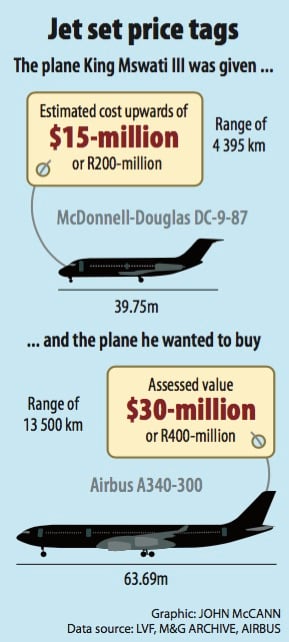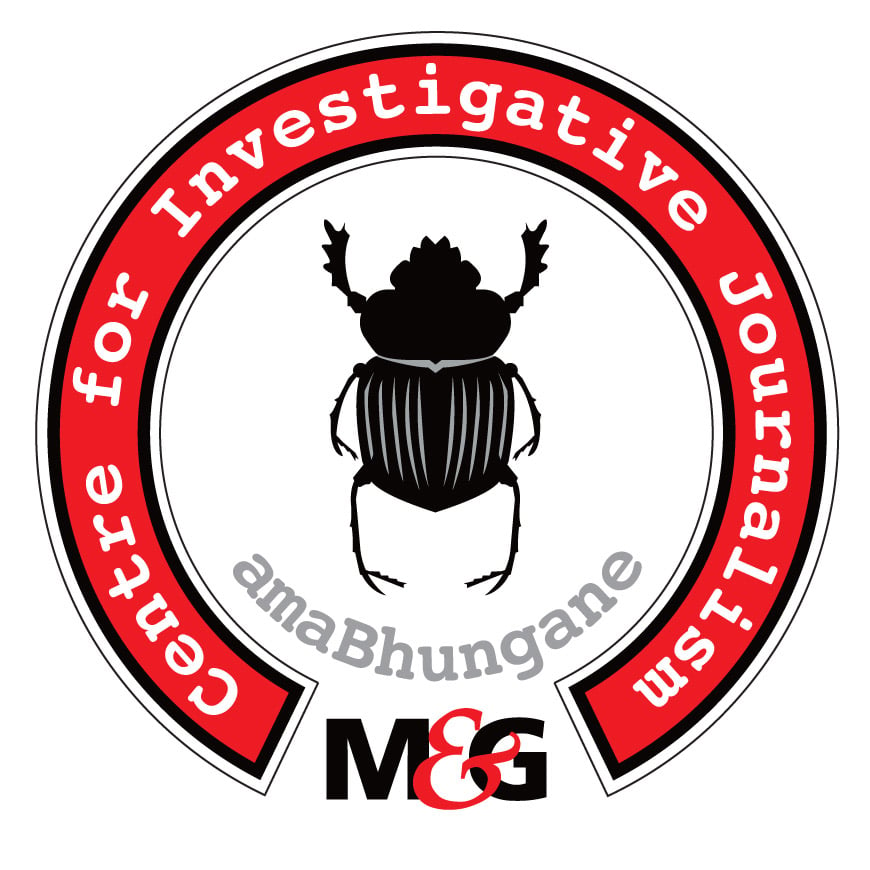King Mswati III.
The Swazi government is forging ahead with plans to acquire a second private jet for free-spending absolute monarch Mswati III, despite a warning by Prime Minister Barnabas Dlamini that the impoverished kingdom is heading for a fiscal crunch.
And amaBhungane has seen documents suggesting that Mswati may be looking to upgrade his current jet, a McDonnell-Douglas DC-9 he received, allegedly as a birthday present, three years ago. A quote by Zurich-based insurers LVF indicates that as early as February this year negotiations were under way to buy the king an Airbus A340-300 HGW.
Although this deal appears to have fallen through, Swazi MPs have okayed a new aircraft.
Although the DC9 is a short- to medium-range aircraft, the Airbus is long range and both longer and wider, with twin aisles and a seating capacity of 85 passengers. Its hourly running costs, at more than $18 000, would have been double those of the DC-9.
The LVF document gives the insured value of the A340 as $30-million – including the refitting done in Canada over nearly a year for $15-million, the same value as the jet.
The timing of the Airbus negotiations raises questions about whether the allegedly spontaneous demand by the Swazi Parliament that the government acquire a new plane was stage managed as a rubber-stamp for a decision already taken. The resolution, passed by MPs without debate in August, came months after the Airbus negotiations and proposed inception date on April 25.
“Ways and means of securing the plane”
Dlamini told an International Monetary Fund mission recently that Swaziland could be on the brink of another fiscal crisis. After similar troubles in 2011, Mswati went cap in hand to South Africa for a R2.4-billion bailout. Dlamini blamed declining revenue from the South African Customs Unions, which contributes more than 50% of Swaziland’s budget, and a large state salary bill. Mswati’s salary – R792-million this year, a 25% increase over 2014 – consumes about 5% of the budget.
Mswati’s spokesperson, Percy Simelane, said last week that a government committee, including Finance Minister Martin Dlamini, had been set up to examine “ways and means of securing the plane”. Simelane said there was budgetary provision and “no new money” would be used for the acquisition.
He also denied rumours that Mswati had driven the purchase of the new jet, saying he “has said nothing on the subject. The decision came from Parliament and government.”
Dlamini said no decision on which plane to acquire had yet been taken and he had no idea when it would be in service. Negotiations were in progress and they would be long. “We have a list of aircraft,” he said. “Call me in the new year.”
He indicated that the plane would be leased, asking: “When did you ever hear of someone buying a jet?”
Industry sources estimated the annual cost of leasing an A-340 – over and above running costs and fixed costs such as insurance – at about $9-million (R122-million).
He also appeared to contradict Simelane on whether the new jet has been budgeted for. “Our financial year ends in March,” he said, implying that the 2016 budget would make provision for it.
“As required by the insured, including all uses incidental for the use of the king of Swaziland”

An embarrassed Swazi government was slow to admit that the DC-9 was impounded in Canada last year, after Mswati’s former Singapore business partner, Shanmuga Rethenam, went to court over millions of rands in debts he claimed Mswati owed him.
It was released only after the Swazis coughed up $3.5-million.
MPs based their demand for a new aircraft on the DC-9’s long absence from Swaziland, arguing that it created a security risk for the king. They expressed disgust at Rethenam for seizing the DC-9 and threatened to petition the Canadian Parliament over what they viewed as disrespect for Swaziland’s sovereignty.
Recalling aviation disasters where planes disappeared off the radar, MP France Dlamini argued that it was not safe for the king to use a jet jinxed by controversy.
Dlamini said the government would need to identify a long-range aircraft to overcome the DC-9’s very short range, which subjected Mswati to many stopovers during long trips, which raised safety concerns.
The LVF document on the apparently abortive Airbus deal states that the plane was to be ferried from Phoenix, Arizona, to Canada. “Thereafter, it will be purchased by the king of Swaziland.” Its uses would be “as required by the insured, including all uses incidental for the use of the king of Swaziland”.
However, aircraft history websites indicate that the plane is currently owned by Meraj Air, an Iranian passenger airline, suggesting the Swazi deal fell through.
The LVF document also states that a company called GainJet “and/or British Virgin Island company to be advised” would be the insurer.
The address is given as the Virgin Islands or Singapore. Why Swaziland should deal through a company in a secrecy jurisdiction is unclear.
A search reveals that the plane is 16 years old, having first been registered on January 28 1999 and operated by Air Canada.
Mswati lives large
King Mswati’s wealth is a closely guarded secret, but it has been variously estimated at between $50-million and $200-million.
In addition to his enormous government salary, Mswati controls the royal investment house, Tibiyo Taka Ngwane, which draws mining royalties and has stakes in the Royal Swaziland Sugar Corporation and hotel chain Swazi Spa Holdings. He has direct stakes in other firms, including 10% of MTN Swaziland.
Canadian court documents indicate that Mswati’s company, Inchatsavane, owns his current jet. Other assets include 12 palaces.
Swaziland’s Gini coefficient is 51.5, meaning that of 187 countries ranked by the United Nations Development Programme in terms of wealth inequality, it stands at 170.
The country’s HIV prevalence is among the world’s highest, at 26%. It has the second-highest rate of HIV-related deaths. – AmaBhungane reporters
* Got a tip-off for us about this story? Click here.
 The M&G Centre for Investigative Journalism (amaBhungane) produced this story. All views are ours. See www.amabhungane.co.za for our stories, activities and funding sources.
The M&G Centre for Investigative Journalism (amaBhungane) produced this story. All views are ours. See www.amabhungane.co.za for our stories, activities and funding sources.